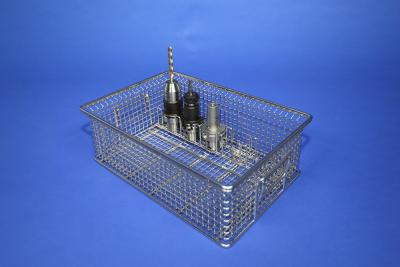
Whether it is drilling, milling or turning, residues from the machining are not only left on the part surface but also in the tools and fixtures. Cleaning of the latter is usually still done manually, even though cleaning of the manufactured parts is carried out in a cleaning machine. Specifically, for toolholders and tool fixtures, Metallform has developed inserts, which can be easily placed in standard cleaning baskets. They enable the fast, process reliable and economical automated cleaning, as well as transport of the assembled toolholder.
Clean toolholders significantly contribute to precision in machining. Therefore, it is surprising that fixtures are still frequently manually cleaned before the tools get replaced, because this process does not ensure that swarf and residues from processing media get removed reliably. Another disadvantage is the high demand on personnel and time caused by each manual process. Additionally, cleaning is usually performed with costly compressed air or brushes and a low flashpoint solvent such as benzine, although virtually every company that manufactures machined parts is equipped with a cleaning machine.
To clean the equipped toolholders also in the cleaning machine, Metallform has developed specific inserts for standard cleaning baskets such as the MEFO-BOX. The inserts are available for different tool fixtures, e.g. HSK, Conus, VDI and SBA, and can be adapted to the type and size of the holders. Fixation of the holder in the insert only takes place at uncritical areas.
Adapted to the size of the working chamber of the cleaning machine, the equipped tool fixtures can be placed vertically or horizontally – e.g. for deep-hole drills – in the insert. This also allows for placing the toolholder directly at the machine or machining centre into the insert and for transporting it safely to the cleaning machine. For cleaning, various and even different inserts can be placed in a MEFO-BOX or standard cleaning basket.
On the one hand, this makes the cleaning of toolholders faster and more process reliable. This is especially due to the open design of the inserts, which allows the cleaning medium and mechanics, e. g. ultrasonic waves or spray jet, to reach the toolholders freely from all sides. In order to improve the cleaning effect, the basket can be swivelled in the machine. On the other hand, automated cleaning increases efficiency. Staff that had been cleaning the tool holders manually can now spend their time with more productive work.
After cleaning and replacing tools the holders can be transported back to the metal cutting machine safely and without damages.
Like all cleaning baskets from Metallform, the inserts are made of stainless steel with an electrolytic polished surface. This high-quality material can be used with all cleaning media and ensures a long service life. The outer structure's rods are butt welded to avoid corners posing the risk of injury.
Contact Details
Related Glossary Terms
- gang cutting ( milling)
gang cutting ( milling)
Machining with several cutters mounted on a single arbor, generally for simultaneous cutting.
- milling
milling
Machining operation in which metal or other material is removed by applying power to a rotating cutter. In vertical milling, the cutting tool is mounted vertically on the spindle. In horizontal milling, the cutting tool is mounted horizontally, either directly on the spindle or on an arbor. Horizontal milling is further broken down into conventional milling, where the cutter rotates opposite the direction of feed, or “up” into the workpiece; and climb milling, where the cutter rotates in the direction of feed, or “down” into the workpiece. Milling operations include plane or surface milling, endmilling, facemilling, angle milling, form milling and profiling.
- swarf
swarf
Metal fines and grinding wheel particles generated during grinding.
- toolholder
toolholder
Secures a cutting tool during a machining operation. Basic types include block, cartridge, chuck, collet, fixed, modular, quick-change and rotating.
- turning
turning
Workpiece is held in a chuck, mounted on a face plate or secured between centers and rotated while a cutting tool, normally a single-point tool, is fed into it along its periphery or across its end or face. Takes the form of straight turning (cutting along the periphery of the workpiece); taper turning (creating a taper); step turning (turning different-size diameters on the same work); chamfering (beveling an edge or shoulder); facing (cutting on an end); turning threads (usually external but can be internal); roughing (high-volume metal removal); and finishing (final light cuts). Performed on lathes, turning centers, chucking machines, automatic screw machines and similar machines.
